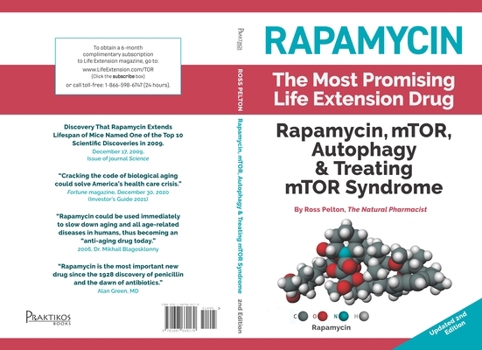Rapamycin: Rapamycin, Mtor, Autophagy & Treating Mtor Syndrome
Select Format
Select Condition 
Book Overview
RAPAMYCIN: A Quantum Leap in Life Extension
Rapamycin, mTOR, Autophagy and Treating mTOR Syndrome
by Ross Pelton
Rapamycin is an FDA-approved drug that is ushering in a new era of life extension. However, to be clear, rapamycin is not approved by the FDA as a life extension drug. In September 1999 rapamycin received FDA approval as an immunosuppressant drug to prevent organ transplant rejection and also, two rapamycin analogs (rapalogs), temsirolimus (Torisel) and everolimus (Afinitor) have gained FDA approval for the treatment of various forms of cancer. However, rapamycin's approval as an immunosuppressant and as a cancer chemotherapy agent has inhibited its acceptance by physicians as a life extension drug.
Treatment with rapamycin has resulted in significant increases in lifespan in animal models including yeast, worms, fruit flies, and mice. Animals get many of the same diseases that humans develop. Results from animal studies reveal that rapamycin slows down the onset of many age-related diseases. In addition to improving animals' health, treatment with rapamycin has produced life extensions ranging from 25-60%.
Discovery of Rapamycin
Rapamycin is a compound that is produced by a strain of bacteria named Streptomyces hygroscopicus.This bacterium was discovered from a soil sample taken during a scientific expedition to Easter Island in 1964. The purpose of that expedition was to search for new compounds that might express antifungal and/or antibiotic properties. Rapamycin expressed strong antifungal activity. However, efforts to develop rapamycin as an antifungal drug were discontinued when it was discovered to have potent immunosuppressive activity.
Rapamycin also exhibited anti-proliferative properties, which prompted scientists to send samples of rapamycin to the National Cancer Institute (NCI). Tests conducted there revealed two remarkable findings. The first revelation was that rapamycin suppressed the growth in a variety of solid tumors.
The second finding was the discovery that rapamycin appeared to be a totally new type of anticancer drug because it functioned by inhibiting cancer growth (cytostatic) rather than by killing cancer cells (cytotoxic). Cytotoxic chemotherapy drugs cause a wide range of side effects because they damage other rapidly dividing cells in the body. Rapamycin's activity against solid tumors plus its cytostatic mechanism of action motivated the NCI to elevate rapamycin to "priority drug" status in order to accelerate additional research.
Rapamycin's Mechanism of Action
Over the past 25 years, research into rapamycin's mechanism of action has resulted in the discovery of a new understanding of cellular biology and the aging process. This research has revealed that two mechanisms named mTOR and autophagy, which are found inside every cell, are critical regulators of cellular metabolism.
mTOR and autophagy are counterbalancing mechanisms that regulate the health and aging process of all living organisms. In my mind, the mTOR/Autophagy story is even more important than the story about rapamycin. The discovery and understanding of mTOR and autophagy are revealing how we can delay the onset of age-related diseases and achieve significant increases in life span and health span.
When rapamycin crosses a cellular membrane and enters a cell, it binds with an enzyme that was named mTOR, which stands for the mechanistic target of rapamycin (mTOR). mTOR is a key regulator of cellular metabolism that has stimulated a great deal of scientific interest.
Now, 25 years after its discovery, over 12,000 papers have been published on mTOR. When nutrients are available to a cell, mTOR sends cellular signals that activate cellular metabolism, telling the cell to use the available nutrients to build new proteins, new enzymes, and other cellular components. mTOR activates cellular anabolic (building) processes of growth and proliferation.
Counterbalancing mTOR is the cellular process known as autophagy. In 2016, Japanese scientist Yoshinori Ohsumi was awarded the Nobel Prize in physiology and medicine for discovering the mechanism of autophagy. PubMed now contains over 30,000 citations with the term autophagy in the title, which gives an indication of the scientific interest in this topic.
Autophagy has been referred to as the cellular housekeeping process or cellular trash removal. Over time, various cellular components become damaged, break down, and become dysfunctional. If these waste products continue to accumulate, cellular functions would decline, and the cell(s) would eventually die. When autophagy is activated, damaged and dysfunctional cellular components are broken down for reuse and recycling or for removal. Autophagy can also be thought of as cellular detoxification.
Animals get many of the same age-related diseases that humans get. Rapamycin gained prominence as a life extension drug based on its ability to treat a variety of age-related diseases and increase the lifespan in numerous species of animals. However, human trials were lacking because ethical issues, costs, and time constraints, make it virtually impossible to conduct life extension trials in humans.
Breakthrough: Rapamycin's Use in Humans
Twas the night before Christmas....on Dec. 24, 2014, a groundbreaking study titled mTOR inhibition improves immune function in the elderly was published that ushered in the era of rapamycin use in humans. The study was conducted by Joan Mannick, MD, who was a senior scientist at Novartis. In addition to being a human clinical trial, Mannick's study is important because it sheds light on WHY and HOW rapamycin can be used safely and effectively in humans to slow down the ons





